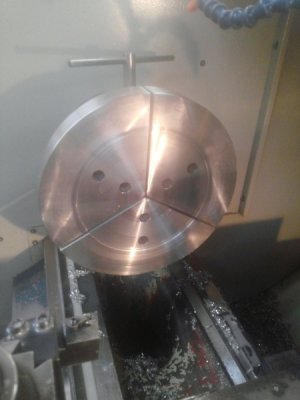I've been puzzled for a long time regarding how people decide whether or not to weld pieces of steel together or bolt them together or to carve up a piece of cast iron to the desired shape for the current project.
Casting are used because it a cost effective way to create large masses and complex structures. It also lends itself to multiple pieces. A sand casting, which the the type used for machine frames starts as a pattern usually made of wood which is used to make a cavity in a sand mold. The pattern is removed and metal is poured or cast in its place. Intricate internal structures can be made using cores. Another type of casting is known as lost wax where a wax models are made and plaster is cast around the wax. The wax is melted out (lost wax) and the cavity filled with the casting metal. This process is often used to make jewelry. Statues are another use. A variant is lost foam where styrofoam is modeled and the plaster cast around it. The metal can be poured directly because the foam, being mostly air, melts into almost nothing and subsequently burns out of the mold. The most expensive process for up-front cost is die casting where a die is machined, hence the high up-front cost. Because the die is reusable, the per piece cost is lower.
Steel is often forged into a semifinal shape with some possible secondary machining. Forging strengthens the metal which is why it used for engine crankshafts, axe heads, and the like. Because the process consists of hammering the steel to fit into dies, parts are limited in their complexity.
Fabrication through weldments is another way to create complex parts. Think of a car frame. Casting a frame is unthinkable, as is machining one from a solid block of steel. It could be bolted or riveted together but bolted or riveted joins are more expensive. Welding can also simplify joinery. Two bars can be welded end to end to make a single bar with uniform cross section. As mentioned in above posts, welding can create thermal stresses, leading to warpage although these can be controlled somewhat with proper technique. If precision fits are required , secondary machining may be necessary.
For precise control of mating surfaces, bolts are often used. When used in conjunction with dowel pins or other locating features, very precise mates can be achieved. Think of your lathe chuck and back plate. Rivets can be a cost effective way to permanently join two pieces.Fastening with bolts or rivets is limited by the strength of same. Bolts are great if you want to take something apart again, however.
Gluing two parts together is limited by the strength of the glue. Generally, the shear strength of the glue bond is considerably lower than that of most metals which is why glue is not normally done. It can work well on nonmetallic materials however. Products like plywood are good examples. And gluing labels on is probably the best way. Glue used in conjunction with mechanical fasteners can be a very effective way to create a stable structure.
As also mentioned above, the material physical properties contribute greatly to the selection of manufacturing process. Cast iron has some great compressive strength but is notoriously poor in tension. Steel is great for tensile strength as well as compressive strength. Welded steel can come very close to the strength of single piece construction.
The internet is a great source of infomation. If you can access Wikipedia, you should be able to find answers there. A number of universities offer on line course auditing for free although I don't know if that extends outside the US. This site is also a great place to learn.
Note: due to my slow typing, some messages came through as I toiled. Please excuse any redundancy.
Bob

